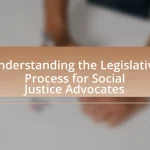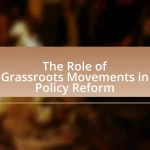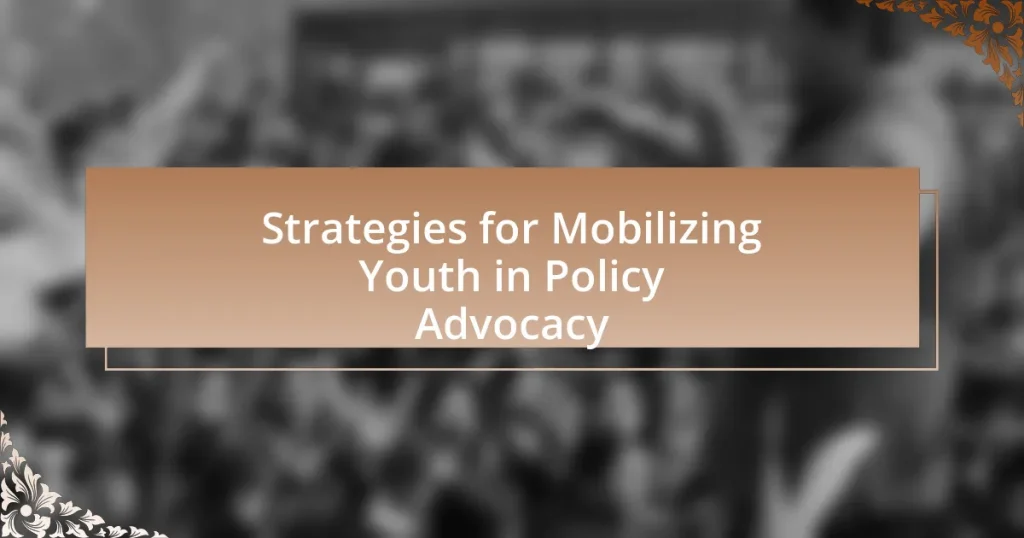The article focuses on strategies for mobilizing youth in policy advocacy, emphasizing the importance of leveraging social media, fostering peer engagement, and providing educational resources. It outlines effective methods for initiating youth engagement, including creating inclusive platforms and utilizing mentorship programs. The article also addresses barriers to participation, the impact of socioeconomic factors, and misconceptions about youth capabilities. Additionally, it highlights the role of youth in shaping future policies and the significance of recognition and feedback mechanisms in sustaining their involvement in advocacy efforts.
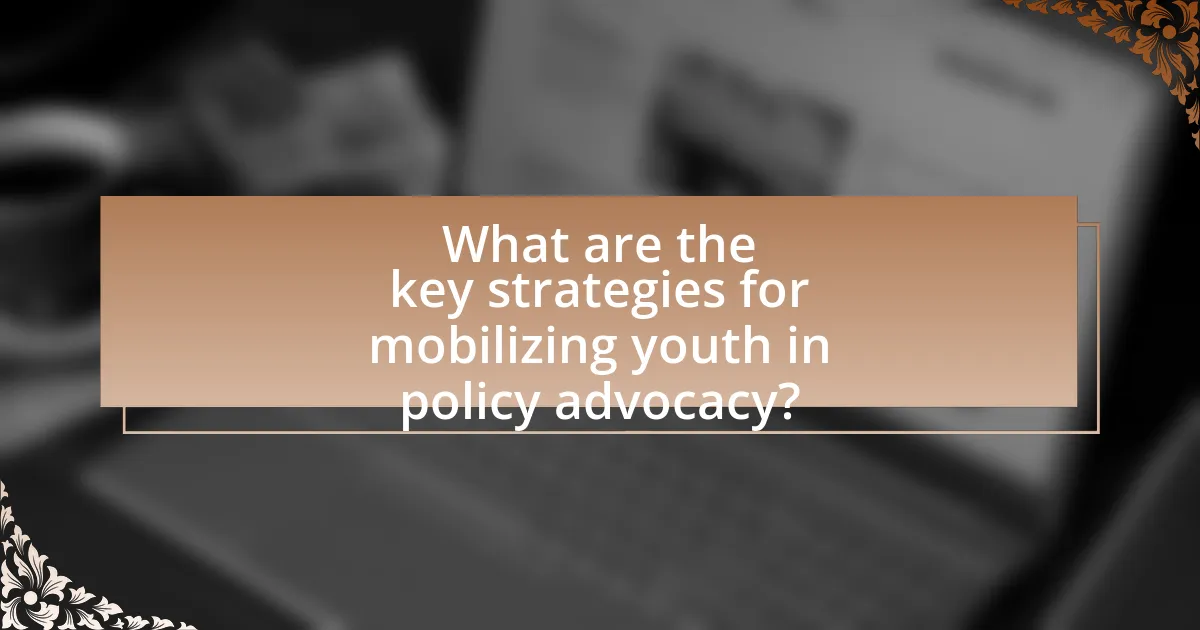
What are the key strategies for mobilizing youth in policy advocacy?
Key strategies for mobilizing youth in policy advocacy include leveraging social media, fostering peer-to-peer engagement, and providing education on policy issues. Social media platforms enable youth to share information rapidly, organize events, and amplify their voices, as evidenced by movements like #FridaysForFuture, which mobilized millions globally for climate action. Peer-to-peer engagement encourages youth to connect with one another, creating a sense of community and shared purpose, which has been shown to increase participation rates in advocacy efforts. Additionally, educational initiatives that inform youth about policy processes and issues empower them to engage effectively, as demonstrated by programs like the Youth Leadership Initiative, which equips young people with the skills needed for advocacy.
How can youth engagement be effectively initiated in policy advocacy?
Youth engagement in policy advocacy can be effectively initiated by creating inclusive platforms that empower young people to voice their concerns and ideas. These platforms should facilitate access to information, training, and mentorship, enabling youth to understand the policy-making process and develop advocacy skills. Research indicates that programs like the Youth Participatory Action Research (YPAR) model have successfully engaged youth by involving them in identifying issues and proposing solutions, thereby fostering a sense of ownership and responsibility. Additionally, collaboration with established organizations can provide resources and networks that enhance youth participation in advocacy efforts.
What role do educational programs play in mobilizing youth?
Educational programs play a crucial role in mobilizing youth by equipping them with knowledge, skills, and a sense of agency necessary for active participation in societal issues. These programs foster critical thinking, enhance awareness of civic responsibilities, and encourage engagement in policy advocacy. For instance, research by the National Youth Leadership Council indicates that youth involved in service-learning programs demonstrate increased civic engagement and leadership skills, which are essential for effective advocacy. By providing structured opportunities for learning and involvement, educational programs empower young individuals to influence policy decisions and contribute to community development.
How can social media be leveraged to engage youth in advocacy?
Social media can be leveraged to engage youth in advocacy by creating interactive platforms that facilitate dialogue, share information, and mobilize action. For instance, campaigns on platforms like Instagram and TikTok can utilize visually appealing content to raise awareness about social issues, encouraging youth participation through hashtags and challenges. Research indicates that 71% of young people are more likely to engage with causes they see on social media, highlighting its effectiveness in reaching this demographic. Additionally, social media allows for real-time communication and community building, enabling youth to connect with like-minded individuals and organizations, thus amplifying their voices in advocacy efforts.
What are the barriers to youth participation in policy advocacy?
Barriers to youth participation in policy advocacy include lack of access to information, limited resources, and systemic discrimination. Youth often face challenges in obtaining relevant information about policy issues, which hinders their ability to engage effectively. Additionally, financial constraints and lack of support from organizations can limit their participation. Systemic discrimination, including ageism and socio-economic disparities, further marginalizes youth voices in policy discussions. Research indicates that these barriers significantly reduce the likelihood of youth involvement in advocacy efforts, as highlighted in studies by the United Nations and various youth organizations.
How do socioeconomic factors impact youth involvement?
Socioeconomic factors significantly impact youth involvement by influencing access to resources, opportunities, and social networks. Youth from lower socioeconomic backgrounds often face barriers such as limited access to education, financial constraints, and fewer opportunities for civic engagement, which can hinder their participation in policy advocacy. For instance, a study by the Pew Research Center found that youth from higher-income families are more likely to engage in community service and advocacy activities compared to their lower-income peers. This disparity highlights how socioeconomic status can shape the ability and motivation of young individuals to participate in civic and political processes.
What misconceptions exist about youth capabilities in advocacy?
Misconceptions about youth capabilities in advocacy include the belief that young people lack the knowledge and experience necessary to influence policy effectively. This perception undermines the reality that many youth are informed, passionate, and equipped with unique perspectives that can drive meaningful change. Research shows that youth-led movements, such as the climate strikes initiated by Greta Thunberg, have significantly impacted global discussions on climate policy, demonstrating that young advocates can mobilize large audiences and influence decision-makers. Additionally, studies indicate that youth engagement in advocacy can lead to innovative solutions and fresh ideas, challenging the stereotype that only older individuals possess the expertise required for effective advocacy.
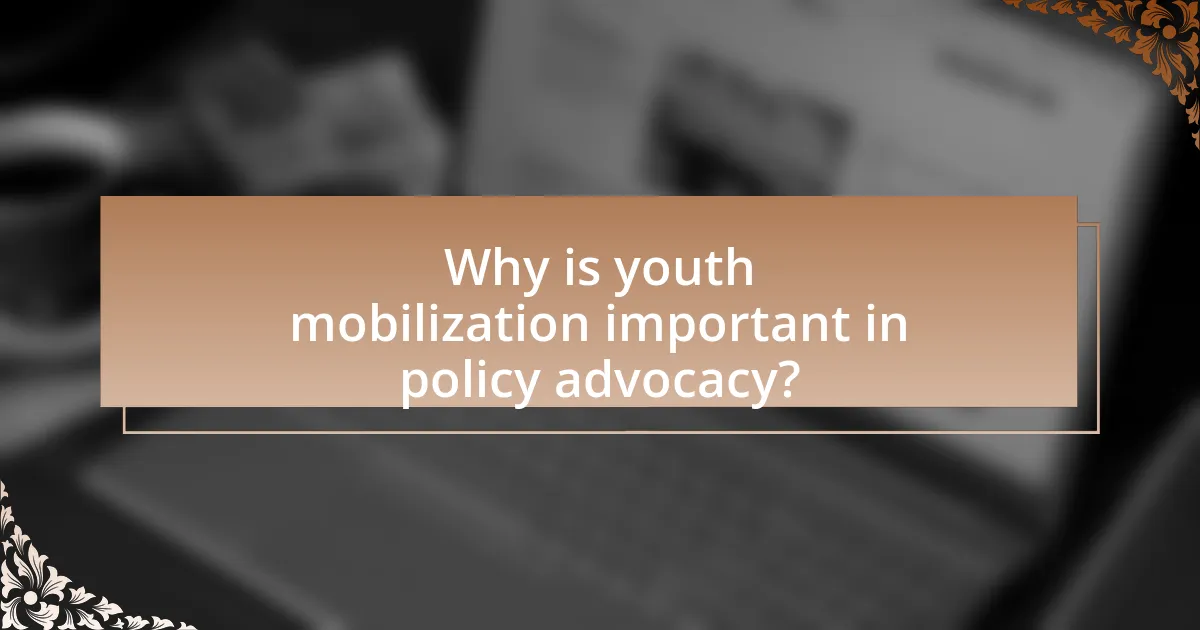
Why is youth mobilization important in policy advocacy?
Youth mobilization is important in policy advocacy because it empowers young individuals to influence decision-making processes that affect their lives and communities. Engaging youth in advocacy ensures that their perspectives and needs are represented, leading to more inclusive and effective policies. Research indicates that when young people participate in advocacy, they can drive significant social change; for example, the 2019 Global Youth Climate Strike mobilized millions of young activists worldwide, resulting in increased political attention to climate issues. This demonstrates that youth mobilization not only amplifies their voices but also catalyzes action on critical policy matters.
What unique perspectives do youth bring to policy discussions?
Youth bring innovative and fresh perspectives to policy discussions, often characterized by their adaptability to change and awareness of contemporary issues. Their unique experiences, shaped by growing up in a rapidly evolving digital landscape, enable them to identify and address challenges such as climate change, social justice, and technology’s impact on society. Research indicates that youth engagement in policy-making leads to more inclusive and representative outcomes, as they advocate for diverse viewpoints that reflect the needs of younger generations. For instance, a study by the United Nations found that youth involvement in decision-making processes enhances the legitimacy and effectiveness of policies, demonstrating their critical role in shaping future-oriented solutions.
How can youth advocacy influence policy outcomes?
Youth advocacy can significantly influence policy outcomes by mobilizing young people to engage in political processes, raise awareness on critical issues, and advocate for change. This engagement often leads to increased visibility of youth perspectives in policy discussions, which can result in more inclusive and representative decision-making. For instance, the 2018 March for Our Lives movement, driven by youth activists, successfully brought gun control to the forefront of national policy debates, demonstrating the power of organized youth advocacy in shaping legislative agendas.
What historical examples demonstrate the impact of youth mobilization?
Youth mobilization has significantly impacted various historical movements, notably during the Civil Rights Movement in the United States. Young activists, such as those involved in the Student Nonviolent Coordinating Committee (SNCC), played a crucial role in organizing sit-ins, freedom rides, and voter registration drives, which were pivotal in challenging racial segregation and discrimination. For instance, the Greensboro sit-ins in 1960, initiated by four college students, sparked a nationwide wave of protests that led to the desegregation of lunch counters across the South. Additionally, the anti-Vietnam War protests in the 1960s saw substantial youth involvement, with students leading demonstrations that influenced public opinion and policy decisions regarding U.S. military engagement in Vietnam. These examples illustrate how youth mobilization can drive social change and impact policy through organized activism and collective action.
How does youth mobilization contribute to democratic processes?
Youth mobilization significantly enhances democratic processes by increasing political participation and fostering civic engagement among younger populations. When young people organize and advocate for their rights and interests, they contribute to a more representative democracy. For instance, the 2018 March for Our Lives movement, initiated by students in response to gun violence, mobilized millions and influenced legislative discussions on gun control in the United States. This demonstrates that youth mobilization can lead to tangible policy changes and greater accountability from elected officials, thereby strengthening democratic governance.
What role does youth play in shaping future policies?
Youth play a critical role in shaping future policies by bringing fresh perspectives, advocating for change, and mobilizing collective action. Their engagement in political processes, such as voting and activism, influences decision-makers and highlights issues that resonate with younger generations, such as climate change and social justice. For instance, the global youth climate strikes initiated by activists like Greta Thunberg have significantly impacted public discourse and policy discussions on environmental issues, demonstrating the power of youth-led movements in driving legislative change.
How can youth advocacy foster civic engagement among peers?
Youth advocacy can foster civic engagement among peers by empowering young individuals to take action on social issues that matter to them. This empowerment occurs through education, skill-building, and creating platforms for youth voices to be heard. For instance, programs that involve youth in community decision-making processes have shown to increase their interest in civic activities, as evidenced by a study from the National Youth Leadership Council, which found that youth who participate in advocacy initiatives are more likely to vote and engage in community service. By facilitating discussions, providing resources, and encouraging collaboration, youth advocacy not only raises awareness but also cultivates a sense of responsibility and agency among peers, leading to increased civic participation.

What practical steps can organizations take to mobilize youth in advocacy?
Organizations can mobilize youth in advocacy by implementing targeted engagement strategies. These strategies include creating platforms for youth voices, such as forums and social media campaigns, which allow young people to express their opinions and share their experiences. Research shows that youth are more likely to engage when they feel their contributions are valued; for instance, a study by the Center for Information & Research on Civic Learning and Engagement found that youth participation increases when organizations provide opportunities for leadership roles and decision-making. Additionally, organizations should offer training programs that equip youth with advocacy skills, such as public speaking and policy analysis, enhancing their confidence and effectiveness in advocacy efforts. By fostering partnerships with schools and community organizations, they can also expand outreach and create a supportive network for youth involvement.
How can partnerships enhance youth mobilization efforts?
Partnerships can enhance youth mobilization efforts by leveraging diverse resources, expertise, and networks to amplify outreach and engagement. Collaborative initiatives between organizations, such as NGOs, educational institutions, and community groups, create a unified platform that increases visibility and credibility among youth. For instance, a study by the United Nations Development Programme highlights that partnerships can lead to a 30% increase in youth participation in advocacy campaigns when multiple stakeholders work together. This collaborative approach not only fosters a sense of community but also provides young people with access to mentorship, training, and funding opportunities, thereby strengthening their capacity to mobilize effectively.
What types of organizations should collaborate with youth advocates?
Nonprofit organizations, educational institutions, government agencies, and community-based organizations should collaborate with youth advocates. These types of organizations can provide resources, expertise, and platforms for youth to engage in policy advocacy effectively. For instance, nonprofit organizations often focus on social issues that align with youth interests, while educational institutions can facilitate training and workshops on advocacy skills. Government agencies can offer insights into policy processes, and community-based organizations can help mobilize local support. Collaborations with these entities enhance the capacity of youth advocates to influence policy decisions and create meaningful change.
How can mentorship programs support youth in advocacy roles?
Mentorship programs can support youth in advocacy roles by providing guidance, resources, and networking opportunities that enhance their skills and confidence. These programs connect young advocates with experienced mentors who can share knowledge about effective advocacy strategies, policy processes, and community engagement. Research indicates that youth involved in mentorship programs are more likely to develop leadership skills and engage in civic activities, as evidenced by a study from the National Mentoring Partnership, which found that mentored youth are 55% more likely to enroll in college and 78% more likely to volunteer regularly. This support system not only empowers youth but also fosters a sense of belonging and purpose, crucial for effective advocacy.
What are effective communication strategies for engaging youth?
Effective communication strategies for engaging youth include utilizing digital platforms, fostering interactive dialogue, and incorporating storytelling. Digital platforms, such as social media and messaging apps, are essential as 95% of teens use smartphones, making these channels effective for outreach. Interactive dialogue encourages participation and feedback, which is crucial since youth value their opinions being heard; studies show that 70% of young people prefer two-way communication. Storytelling resonates with youth, as narratives can evoke emotions and create connections; research indicates that stories are 22 times more memorable than facts alone. These strategies collectively enhance engagement and ensure that youth feel valued and involved in policy advocacy.
How can storytelling be used to inspire youth participation?
Storytelling can inspire youth participation by creating relatable narratives that resonate with their experiences and aspirations. Engaging stories can illustrate the impact of civic involvement, making abstract concepts tangible and motivating young individuals to take action. Research shows that narratives can enhance emotional connections, leading to increased empathy and a sense of agency among youth. For instance, a study by the Stanford Social Innovation Review highlights that storytelling in campaigns can lead to a 30% increase in youth engagement in social issues. By presenting real-life examples of youth making a difference, storytelling empowers young people to envision their role in advocacy and encourages them to participate actively.
What messaging resonates most with young advocates?
Messaging that resonates most with young advocates emphasizes authenticity, social justice, and community impact. Young advocates are drawn to messages that reflect their values and experiences, particularly those that highlight the importance of equity and inclusivity. Research indicates that 70% of young people are motivated by causes that align with their personal beliefs and demonstrate a clear connection to their communities. This alignment fosters a sense of purpose and urgency, making them more likely to engage in advocacy efforts.
What best practices should organizations follow to sustain youth engagement?
Organizations should implement inclusive decision-making processes to sustain youth engagement. By actively involving young people in the planning and execution of programs, organizations can ensure that their voices are heard and their needs are addressed. Research indicates that youth who feel their contributions are valued are more likely to remain engaged; for instance, a study by the National Youth Leadership Council found that youth participation in decision-making leads to increased motivation and commitment to initiatives. Additionally, providing mentorship opportunities fosters personal growth and strengthens connections between youth and organizational leaders, further enhancing engagement levels.
How can feedback mechanisms improve youth advocacy initiatives?
Feedback mechanisms can significantly enhance youth advocacy initiatives by ensuring that the voices and concerns of young people are actively heard and addressed. These mechanisms facilitate two-way communication, allowing youth to provide input on policies and initiatives that affect them, which can lead to more relevant and effective advocacy efforts. For instance, studies show that organizations implementing feedback loops report higher engagement levels among youth participants, as they feel their opinions are valued and impactful. This increased engagement can result in more robust advocacy campaigns that resonate with the target audience and lead to tangible policy changes.
What role does recognition play in maintaining youth involvement?
Recognition plays a crucial role in maintaining youth involvement by validating their contributions and fostering a sense of belonging. When young individuals receive acknowledgment for their efforts, it enhances their motivation and commitment to participate in advocacy activities. Research indicates that recognition can lead to increased engagement levels; for instance, a study by the National Youth Agency found that 70% of youth reported feeling more motivated to participate in initiatives when their contributions were recognized. This validation not only reinforces their self-esteem but also encourages ongoing participation, creating a positive feedback loop that sustains their involvement in policy advocacy.
